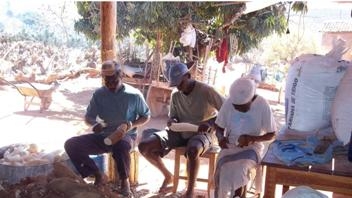Challenge
Quilombolas are the descendants of African slaves with distinctive cultural values, religious beliefs, and livelihoods. They maintain a distinctive collective identity and a strong attachment to their communities. However, quilombola communities in the states of Bahia, Ceará, and Pernambuco lack access to basic public services and are overrepresented among the poor and extremely poor populations. Moreover, as a result of social exclusion, or marginalization, these communities confronted barriers in terms of organizational skills, access to information, and the experience necessary to identify and access the necessary external financing for improved public services.
Solution
A project grant from the World Bank-executed Leveling the Playing Field for Quilombola Communities in Northeastern Brazil: Ceará, Pernambuco and Bahia States Trust Fund was designed to broaden the participation of quilombola leaders and empower the remote quilombola communities by improving their ability to engage in collective action and community-level initiatives. Workshops carried out in preparation for the project identified the barriers that isolate remote communities, such as the lack of telephone lines, inadequate access to the Internet, and other basic physical infrastructure. To tackle these barriers, the project developed new or strengthened existing community organizations and provided information on government programs and other public and private resources. Project activities addressed the lack of official documentation regarding such issues as official recognition, association status, or land tenure documentation. The project’s technical assistance addressed the need for culturally appropriate and participatory technical assistance in community planning, developmental and participatory initiatives, preparation of community proposals for external financing and monitoring and evaluation. The technical assistance included training in basic administration, accounting, subproject preparation, implementation and monitoring and evaluation.
Results
The project contributed significantly to raising the visibility of quilombola communities and strengthening the participation of quilombola leaders in policy decision-making. Quilombola communities forged partnerships with regional and state quilombola movements, and multiple government agencies. Quilombola communities now enjoy greater access to information, state policies, and public services.
Improvements in organization and increased funding of local projects demonstrate the strengthened participation of the quilombola organizations. For example, the number of formalized, well-functioning and broadly representative community associations grew by 35 percent in the three states. The communities also improved their awareness of public and private funding or services, as measured by (i) a 35 percent increase in the local priority initiatives identified and matched with external funding sources and (ii) a 30 percent increase in the formulation and approval of community-based sustainable development initiatives. Finally, the communities improved the participation of community members in local decision making, as measured by (i) a 25 percent increase in the number of representatives actively involved in the rural poverty project’s municipal councils and other key decision-making bodies and (ii) a 15 percent increase in the number of externally funded proposals from quilombola communities.
Bank Group Contribution
The Bank supported the project activities and training with a grant of US$1.9 million from the Japan Social Development Fund (JSDF).
Partners
The JSDF funding supported the project activities and technical assistance at the local and state levels. The project worked with state and local organizations to identify and implement the project components. The partners included state and local governments, the community-based organizations Quilombola Territorial Councils and the Bahia State Council of Quilombola Communities and Associations, the Ceará State Commission for the Rural Quilombola Communities and the Ceará Institute of Rural Quilombola Communities, among others. The three implementing agencies were the Companhia de Desenvolvimento e Ação Regional (CAR) in Bahia, the Secretaria de Desenvolvimento Agrário (SDA) in Ceará, and the Programa Estaudal de Apoio ao Pequeno Produtor Rural (Prorural) in Pernambuco.
Moving Forward
Building on the progress made, state governments are funding new or existing programs to benefit the quilombola communities. In Bahia, the state’s Vida Melhor Program allocated nearly a R$500,000 to finance the project “Innovation, Sustainability and Institutional Strengthening for the Consolidation of Quilombolas’ Needs.” In Ceará, the state government established a productive inclusion program, which provided R$1 million to productive inclusion projects for quilombola communities.
Beneficiaries
The beneficiaries included the quilombola communities and the state and community level organizations. In Bahia, the project supported the creation of seven Quilombola Territorial Councils and the Bahia State Council of Quilombola Communities and Associations. In Ceará, the project strengthened the State Commission for the Rural Quilombola Communities (CEQUIRCE). In Pernambuco, 120 quilombola representatives of 46 project beneficiary communities participated in 56 decision-making arenas, such as territorial, municipal and state councils. The project’s technical assistance supported the preparation of 327 community subprojects. Of these, 96 have were approved for external funding, benefiting 24 percent of the targeted quilombola communities.
In all three states, project beneficiaries emphasized how the project contributed to raising the self-esteem of the communities. Many beneficiaries mentioned the importance of bringing them together to rebuild the group perspective and to learn about their culture and history. Going forward, the communities will continue to benefit from their improved advocacy skills and a greater capacity to make their voices heard; increased awareness about local priorities, civil rights, and state policies available for the quilombola population; and from their enhanced relationship with the government agencies.
